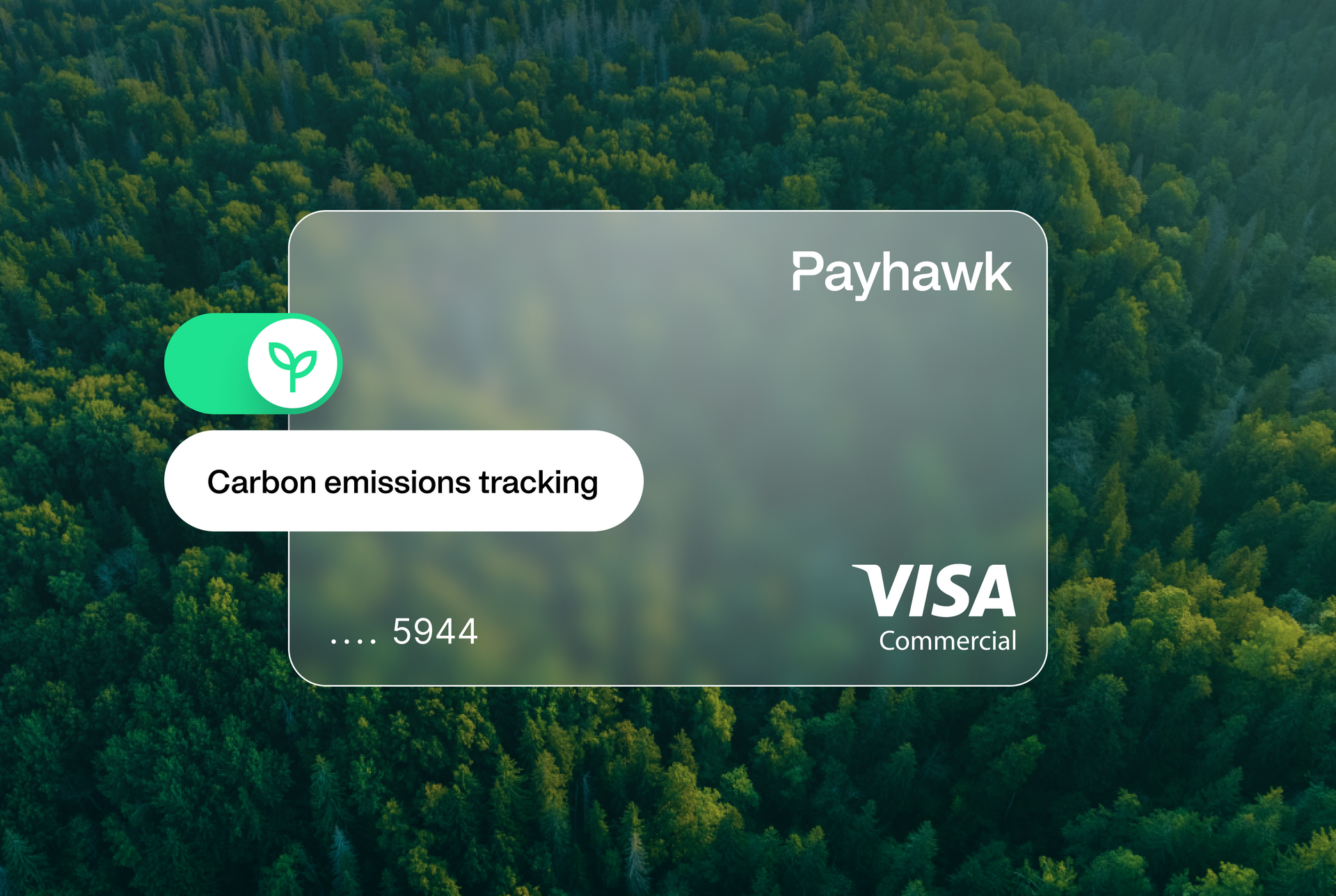
How to Meet Reporting Standards for ESG



In today's business landscape, the significance of environmental, social, and corporate governance (ESG) has grown immensely. With new regulations taking effect across the EU (and anticipated in the US), your business must integrate ESG (and ESG reporting) into its practices.
By submitting this form, you agree to receive emails about our products and services per our Privacy Policy.
In our recent webinar, The Finance Team’s Role in ESG: How to prepare your business, Payhawk's CFO Konstantin Dzhengozov and Director of Product Engineering Robbie Hadfield joined experts Veroniki Zerva from Accounting for Sustainability (A4S) and David Wray from the International CFO Alliance. Together, they provided critical insights on simplifying ESG reporting for finance teams, emphasizing:
- How to streamline the planning processes for the 2024 cycle
- How to identify key ESG factors for sustainable risk assessment
- How to implement efficient practices to speed up ESG planning
This article distills some of the most critical insights and offers tips for kickstarting your reporting journey.
Webinar: Get your finance team ready for ESG reporting
What is ESG?
ESG reports will help your company offer more transparency over advancements towards environmental sustainability and corporate governance objectives. Like an annual report or other corporate disclosures, the ESG report functions as a communication medium, letting you disseminate information to employees, investors, and regulatory bodies.
Why ESG scoring and standards are important
As ESG credentials have become increasingly important to employees, consumers, and investors (82% of investors aged 18-34 say they’re willing to “take a hit” to support ethical investments), organizations have begun formalizing the way they score, report, and communicate around it.
The introduction of CSRD means investors and other stakeholders can access relevant information more easily, letting them better assess investment risks related to ESG and sustainability. Of course, the reporting also means that as a business, you can assess your company’s impact and prioritize new initiatives to reduce things like environmental damage, improve ethical decision-making, and more.


Expert tips on preparing for ESG reporting
Before we dig into some of the finer details of ESG reporting, here are some of Veroniki Zerva’s top recommendations:
- Check what will apply to you
- Assess what may be material for your organization
- Run gap analysis on reporting and disclosure
- Assess the maturity of your control environment for capturing sustainability information
- Transform your reporting processes for the above
Watch our on-demand webinar to find out more.
What are the reporting requirements?
Who?
Several different bodies, councils, and other organizations are involved in setting and rolling out regulations around ESG. Here are some of the key facts, people, and figures to remember:
- In January 2023, the European Council of the EU initialized the Corporate Sustaining Reporting Directive (CSRD). This directive creates legislation around ESG requirements while extending the range of companies required to report on ESG and sustainability issues.
- July 2023: [The European Sustainability Reporting Standards](https://finance.ec.europa.eu/news/commission-adopts-european-sustainability-reporting-standards-2023-07-31_en] make it mandatory for companies to audit sustainability information, and this means the Commission and its auditors can approach them at any time. These standards are strongly linked to ongoing European Commission initiatives but also build on international legislation and "set the structure and disclosure requirements that organizations like banks and insurance companies will need to report on if in scope".
- The CSRD reporting regulations will apply to most companies listed in the EU, large subsidiaries of non-EU companies, and businesses with a turnover exceeding €150 million within the Eurozone.
- CSRD has also become vital to the Sustainable Finance Action Plan (SFAP). The SFAP is a "policy objective set by the EU which aims to promote sustainable investment"
and captures a wide range of finance and real estate companies.
What?
When developing a comprehensive ESG strategy
, you should craft a business case that prioritizes sustainability as one of your company's driving forces. This involves creating a materiality matrix that addresses key topics and indicators reflecting your significant ESG impacts, including Scope 3. Ensure your strategy encompasses areas significantly influencing stakeholders' assessments and decisions and aligning them with sustainable practices.
Eighty-five percent of SMBs want to understand better and control the emissions from their spending, according to carbon-accounting and offsetting company Lune. Of course, Scope 3 emissions play a necessary (but complicated) part here.
Erik Stadigh, co-founder at Lune, says:
"Scope 3 emissions are undoubtedly more complicated than scopes 1 and 2. However, dealing with these emissions is vital as they can help you collaborate with suppliers and peers to create an even bigger, more positive impact. If you aim for net zero, then minimizing these emissions is essential to your journey."
Where?
The ESG reporting requires companies in the EEA to publish data collected from 2024 in 2025. It affects companies with +500 employees, which is approximately 50,000 companies in the EEA. But it also impacts companies outside the EEA if they have EEA-based entities; in the US, for example, it's expected to affect +2000 businesses.
When?
Reporting requirements begin imminently in the 2024/25 financial year.
How to meet the reporting standards
Here are six steps you can take to help you meet the reporting standards for ESG (Environmental, Social, and Governance):
- Understand ESG reporting: Educate yourself on the ins and outs of ESG reporting and explore how reporting on risks and activities will look across the different areas of your business
- Identify relevant frameworks: Assess which ESG reporting framework suits the objectives and market of your company the best
- Collect ESG data (call in the experts): Compile information on governance, social, and environmental factors. Here, we recommend leveraging software to help you collect the data most efficiently. At Payhawk, for example, our spend management solution can do several significant things to help here, including estimating the CO2 impact of card spending (together with our partner Lune) and capturing difficult-to-quantify Scope 3 supplier data
- Report and disclose: Prepare ESG reports that adhere to the chosen framework's guidelines and present the ESG performance, initiatives, and risks transparently and concisely
- Engage stakeholders: Include interested parties in preparing ESG reports
- Data management: Improving data management procedures is necessary to guarantee the dependability and correctness of ESG data, which is essential for credibility and compliance
David Wray adds:
"When we think about CSRD, where we're going, and the influence we have... It's not always beneficial to say 'just pull out from working with a supplier' who's not meeting your standards, but rather to help them transition to more sustainable models."
Why gap analysis is important and what to do next
As Veroniki Zerva details:
“Gap analysis will help you determine what you have in place and what you need to do to close the gaps.”
The analysis will help you compare your current performance with your expectations and desires. It will allow you to pinpoint discrepancies between your reporting and expectations and create an action plan to close them.
When faced with new reporting requirements, there might be a tendency to rush into them without a thorough assessment. Your organization should take a step back and understand your supply and value chains better first.
Need more info on gap analysis, material assurances, and more? Watch our eye-opening on-demand webinar to get crucial insights and strategies from industry experts and get set to navigate the complexities of ESG reporting.
Trish Toovey works across the UK and US markets to craft content at Payhawk. Covering anything from ad copy to video scripting, Trish leans on a super varied background in copy and content creation for the finance, fashion, and travel industries.
Related Articles


Beyond ESG compliance: How carbon reporting drives corporate sustainability

